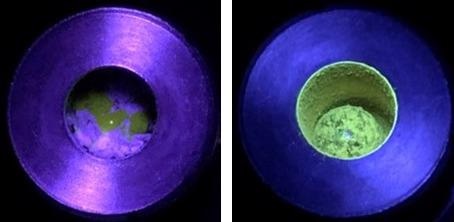Jun 14 2021
Scientists from Hokkaido University have successfully devised a new technique that imparts luminescent properties to generic polymers like polyethylene and polystyrene.
 Ball-milling the mixture of polystyrene and pre-fluorescent radical reactants yielded luminescent polymers. Photos show the mixture before (left) and after (right) the reaction, under UV light. Image Credit: Koji Kubota et al., Angewandte Chemie International Edition. May 14, 2021.
Ball-milling the mixture of polystyrene and pre-fluorescent radical reactants yielded luminescent polymers. Photos show the mixture before (left) and after (right) the reaction, under UV light. Image Credit: Koji Kubota et al., Angewandte Chemie International Edition. May 14, 2021.
Published in the Angewandte Chemie International Edition journal, the new technique makes it viable to prepare luminescent polymers easily and without using complex organic synthetic methods.
Luminescent polymers are widely used in modern society, in applications such as organic lasers, solar cells, sensors, and bioimaging, but their preparation often requires multiple chemical synthesis steps, which are both time and labor-intensive.
Hajime Ito, Study Co-Author and Vice Director, Institute for Chemical Reaction Design and Discovery (WPI-ICReDD), Hokkaido University
To address this issue, the researchers checked whether luminescent polymers could be prepared using mechanical force rather than advanced chemical synthesis.
It is well known that mechanically stimulating polymers, for example by grinding or crushing them, generates reactive species called free radicals. Inspired by this phenomenon, as well as our previous research into mechanical-force-induced luminescence and reactions, we wanted to investigate whether we could find a simpler method for preparing functional luminescent materials.
Koji Kubota, Study Co-Author and Associate Professor, Hokkaido University
In this analysis, the polymer and the pre-fluorescent radical reactant were placed together in a ball milling jar comprising stainless steel balls. The jar was subsequently shaken so that the ball grinds the solid compounds and triggers a reaction.
During the course of the process, the covalent bonds in the polymer chains were cleaved collectively, then pre-fluorescent molecules were placed into the polymer. This resulted in considerably higher emission intensity.
This method was successfully applied to polyethylene, polystyrene, polysulfone, polyphenylene sulfide and other generic polymers.
With further development, the method could potentially be adapted to introduce other functions to generic polymers.
Mingoo Jin, Assistant Professor, Hokkaido University
Hajime Ito added, “In the future, we hope to use this method to develop novel sensing and recording materials that change colour in response to mechanical stimuli.”
The new method can pave the way for developing “smart materials” for a variety of applications, like pressure-sensitive sensors and bioimaging reagents.
Journal Reference:
Kubota, K., et al. (2021) Introduction of a Luminophore into Generic Polymers via Mechanoradical Coupling with a Prefluorescent Reagent. Angewandte Chemie International Edition. doi.org/ 10.1002/anie.202105381.